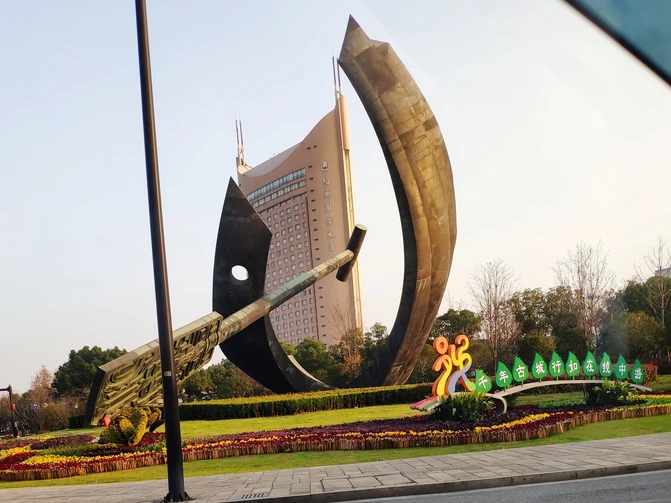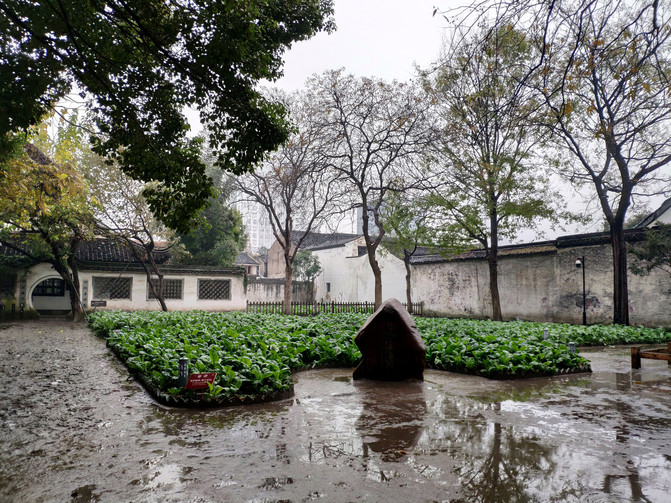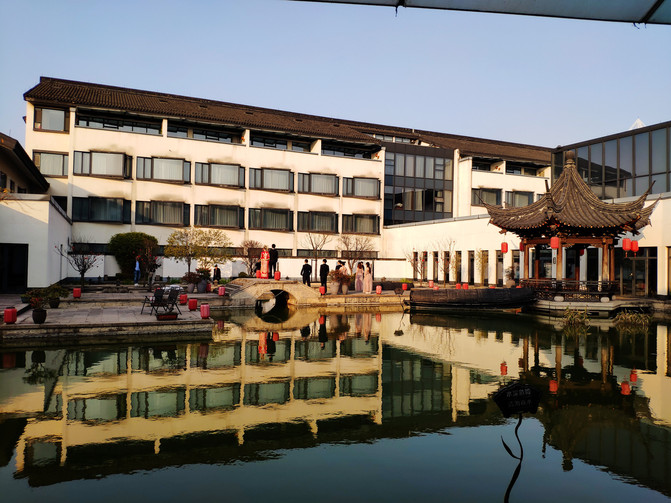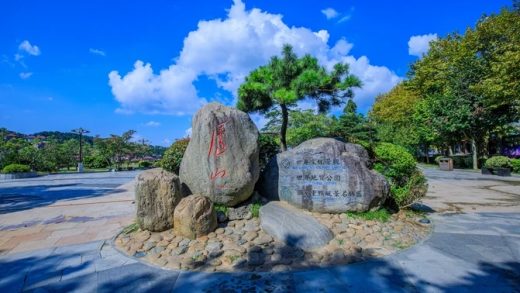
A 3-Day Sojourn in Shaoxing: Unveiling Ancient Charm and Cultural Treasures
On December 18 – 20, 2020, my wife and I embarked on a spontaneous short – break getaway to Shaoxing. We booked our hotel and high – speed train tickets on Ctrip, looking forward to exploring this ancient city full of historical and cultural heritages.

Day 1: The Hometown of Lu Xun and the Night at Shenyuan Garden
- Arrival and Lunch: After a one – and – a – half – hour high – speed train ride from Shanghai, we arrived at Shaoxing North Station at 11:30. A 40 – yuan taxi ride took us to the “Xunbao Ji” (Lu Xun Branch) near the intersection of Jiefang Road and Lu Xun Middle Road. It was a Friday, so the restaurant wasn’t crowded. We ordered signature dishes like Braised Pork with Preserved Vegetables, Yellow Croaker Steamed in Huadiao Wine, Shaoxing Three – Delicacy Soup, and Shaoxing Cakes, along with half a catty of Huadiao Wine. The food was delicious, and the wine was sweet. With a performance of Yue Opera in the lobby, it was a wonderful experience. The total bill was only 281 yuan.
- Check – in at Xianheng Hotel: Just 200 meters from the restaurant, we reached Xianheng Hotel. The top of the corridor at the entrance is in the shape of a boat canopy. The four – character plaque “Pin Wu Xian Heng” at the front desk is from the “Book of Changes”, meaning all things are prosperous. We were upgraded to a suite as VIP customers. After a bit of wine, we took a short nap.
- Exploring the Hometown of Lu Xun: At 15:15, we started our visit to the Hometown of Lu Xun. The tour route included Lu Xun’s Ancestral Residence, Sanwei Study, Lu Xun’s Former Residence, Baicao Garden, the Scenic Area of Lu Xun’s Works, and the Lu Xun Memorial Hall. We got free passes after showing our green health codes and registering.
- Lu Xun’s Ancestral Residence: The old mansion covers an area of 3087 square meters, with black – tiled roofs and whitewashed walls, a typical feudal scholar – official’s residence. The “Deshou Hall” implies good virtue and long – lasting fortune. There’s also a “National Backbone” memorial archway between the ancestral residence and Sanwei Study, showing people’s respect for Lu Xun.
- Sanwei Study: It was the residence of Lu Xun’s teacher, Mr. Shou Jingwu. Lu Xun studied here for about five years. Different halls in the study have different functions and plaques with profound meanings, like the “Sanyu Study” which encourages people to make use of every spare moment to study.
- Lu Xun’s Former Residence: The new mansion also has a “Deshou Hall” with a “Pine and Crane Picture” and couplets.
- Baicao Garden: It’s an ordinary vegetable garden where Lu Xun played with his friends in childhood, just as described in his famous essay “From Baicao Garden to Sanwei Study”.
- The Scenic Area of Lu Xun’s Works and Lu Xun Memorial Hall: The memorial hall was inscribed by Guo Moruo. Inside, there’s a large bronze statue of Lu Xun. The exhibits show Lu Xun’s life, from his family’s decline in his youth to his decision to abandon medicine for literature, and his great contributions to China’s cultural revolution.
- Dinner at Xianheng Hotel: At 18:00, we had dinner at the Flavor Restaurant of Xianheng Hotel, the prototype of the one in Lu Xun’s story “Kong Yiji”. Outside the door, there’s a statue of Kong Yiji holding a fennel seed. We ordered Taidiao Wine, Anchang Sausages, Shaoxing Crispy Fish, Braised Pork Bones with Radish, Sweet Fermented Rice, and Vegetable Rice, spending 248 yuan.
- The Night at Shenyuan Garden: At 19:15, we arrived at Shenyuan Garden, 200 meters east of the Hometown of Lu Xun. The night view was dreamy under the lights. From 19:40 to 20:30, a Yue Opera performance told the sad love story between Lu You and his cousin Tang Wan.
Day 2: Lanting, Cangqiao Straight Street, Zhou Enlai’s Former Residence, Cai Yuanpei’s Former Residence, and the Calligraphy Saint’s Hometown Block
- Lanting Scenic Area: Located about 13 kilometers southwest of the city, it cost us about 40 yuan to take a taxi there.
- Group of Sages Pavilion: In the ninth year of Yonghe in the Eastern Jin Dynasty, Wang Xizhi invited more than 40 friends here for a gathering, and he wrote the famous “Lanting Collection Preface”. Unfortunately, the original calligraphy is now lost as it was buried with Emperor Taizong of the Tang Dynasty.
- Goose Pond: There’s a triangular stele pavilion with the characters “Goose Pond” on the stele. The “Goose” character was written by Wang Xizhi, and the “Pond” character was added by his son Wang Xianzhi.
- Lanting Stele Pavilion: Built in the Kangxi period of the Qing Dynasty, the “Lanting” characters on the stele were written by Emperor Kangxi. It was damaged during the Cultural Revolution and later repaired with some parts missing.
- Qu Shui Liu Shang: It’s a famous scenic spot in Lanting, showing the scene described in the “Lanting Collection Preface”. The “Liushang Pavilion” was built to commemorate this activity.
- Imperial Stele Pavilion: It has a 300 – year – old stele written by both Emperor Kangxi and Emperor Qianlong, so it’s also called the Grandfather – Grandson Stele.
- Eighteen Cylinders by the Pond: The story of Wang Xianzhi practicing calligraphy with these cylinders shows his perseverance.
- Lanting Stele Forest: It collects works of 21 deceased calligraphers about Lanting.
- Wang Youjun Shrine: It’s the essence of Lanting, with a pond where Wang Xizhi washed his brushes and a pavilion where he played the piano.
- Lanting Calligraphy Museum: Built in 1988, it displays the brief history of Chinese calligraphy.
- Cangqiao Straight Street: It took us 20 minutes and 39 yuan to take a taxi back to the city. The street is 1.5 kilometers long, consisting of residential houses, rivers, and neighborhoods. Many traditional houses from the late Qing Dynasty and early Republic of China are well – preserved, with a strong water – town style. We tried the popular Yellow Rice Wine Milk Tea at Huijingxuan and authentic stinky tofu. Due to being full, we skipped other restaurants. We also passed by the famous traditional Chinese medicine shop “Zhenyuantang”. We tried to find the Qingteng Study but failed because of road construction. Then we had lunch at Xunbao Ji again. After that, we went back to the hotel for a rest.
- A Trishaw Tour of the Ancient City: At about 3:30 p.m., we called the trishaw driver Zhang Tumu we met at the Hometown of Lu Xun. Due to time constraints (the former residences close at 17:00), we went straight to Zhou Enlai’s Former Residence.
- Zhou Enlai Memorial Hall: Zhou Enlai is a descendant of Zhou Dunyi. His ancestors moved to Shaoxing in the Yuan Dynasty and settled here in 1381. Zhou Enlai lived and studied here in his childhood and also stayed here during his revolutionary activities in 1939. There’s a white marble statue of Zhou Enlai in military uniform in the Xiyang Hall, and the couplets in the hall summarize his great life.
- Cai Yuanpei’s Former Residence: We entered just before 16:40. The residence in Bifei Lane is a typical Ming – Qing style mansion where Cai Yuanpei was born and carried out revolutionary activities. There are inscriptions by famous people like Liu Haisu and Mao Zedong.
- The Calligraphy Saint’s Hometown Block: The former residence of Wang Xizhi is now the Jiezhu Temple. The name comes from a sad story where Wang Xizhi wrongly suspected a monk of stealing his pearl, and the monk committed suicide. To atone for his mistake, Wang Xizhi converted his house into a temple. Opposite the temple is the Ink Pond, where Wang Xizhi practiced calligraphy and turned the water black. There’s also the Tishang Bridge with an interesting story about Wang Xizhi writing on fans for an old woman.
- Dinner: In the evening, we had a bowl of vegetable soup noodles at a small noodle shop near the Hometown of Lu Xun. It tasted great after several rich meals.
Day 3: Bazi Bridge, East Lake, Shaoxing Museum, and Shenyuan Garden
- Morning Bike Ride to Bazi Bridge:
- Passing by the Monument of Martyr Qiu Jin: The monument was built in 1933 to commemorate Qiu Jin, a revolutionary martyr who was executed in 1907. There’s a statue of Qiu Jin with an inscription by Sun Yat – sen.
- Passing by Dasha Tower: It’s one of the four famous towers in Shaoxing, a provincial – level cultural relic. The current tower is a Ming – Dynasty building, damaged in the Qing Dynasty but still standing.
- Bazi Bridge: Built in the Southern Song Dynasty, it’s named for its shape like an eight – character. It’s a wonderful example in the history of Chinese bridge architecture, solving complex traffic problems at the intersection of three streets, three rivers, and four roads.
- East Lake Scenic Area: It’s 5 kilometers east of Shaoxing. The lake was formed after centuries of stone – quarrying. In the late Qing Dynasty, a garden was built according to the concept of “The Peach Blossom Spring”. We took a four – person boat ride on the lake, passing through the Taogong Cave and the Xiantao Cave. There’s also a stage for water – based opera performances. We spent about two hours in the scenic area.
- Shaoxing Museum: After leaving the East Lake, we took a 10 – minute taxi ride to the museum at the foot of Fushan Mountain. The museum is a great place to understand the history of Shaoxing. There’s an abstract bronze sword sculpture in the square with an in – depth introduction to Shaoxing on it. The museum showcases the history of the ancient Yue Kingdom, with important exhibits like the Yue King Goujian’s story, the Wu King Fuchai’s sword, and the cultural heritage of Shaoxing.
- Shenyuan Garden: It’s 200 meters east of the Hometown of Lu Xun. The garden is a famous Song – Dynasty garden with a history of over 800 years. It’s full of pavilions, bridges, and green trees. The two versions of the poem “Chai Tou Feng” by Lu You and Tang Wan are well – known. We also saw some other scenic spots like the well in the pavilion, the Banbi Pavilion, and the Jiannan Academy.
- Dessert and Heading Home: Before leaving, we had some sweet fermented rice, lotus root cakes, and dried pork with preserved vegetable cakes near the Hometown of Lu Xun. Then we headed to Shaoxing North Station, looking forward to coming back again to explore the places we missed, like Ke Rock Scenic Area and Dayu Mausoleum.

This 3 – day trip to Shaoxing was full of cultural discoveries and delicious food, leaving us with unforgettable memories.







